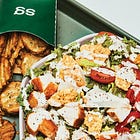Cherry-picked lows and highs from Q2 2025
It’s a rough time to be a fast casual restaurant, but it’s a great time to be a delivery giant!
You can learn a lot from a restaurant’s finances. But you can learn more from how its executives explain them.
For example, Sweetgreen, which lost over $23 million in the second quarter of 2025, seems to be having an identity crisis. Well into the company’s August 7 call, CEO Jonathan Neman casually dropped news that the chain was discontinuing its ripple fries after just months on the menu. Sweetgreen launched the fries in March to much fanfare — I even flew to the chain’s Los Angeles HQ to try them ahead of the nationwide launch.
The fries, Neman said, turned out to be a distraction. A “complexifier,” even. (I had never heard that word before; apparently billionaire Jeff Bezos injected it into the English language six years ago.) Instead, the chain will focus on its core offering: healthy salads and bowls. (Now with more protein; the chain recently upped portions of protein including chicken and tofu inside its dishes.)
Thanks in part to the portion sizes, customers are already happier, Neman said, and he expects “substantial improvement over the coming quarters.” But that doesn’t soften the blow of a particularly bad quarter.
“Let me be clear, we are not satisfied with the results we're reporting today,” Neman said during the call.
Investors weren’t happy either; the stock dropped 23 percent and hasn’t recovered.
Other restaurant stocks dipped, too, including Chipotle (12 percent immediately following earnings) and Cava (also a post-earnings 23 percent) in part due to slowing sales and what Cava’s chief financial officer called “a fog for consumers where things are changing constantly.”
In fact, most restaurant leaders spoke of a “softer” consumer this earnings season, describing them as hesitant or even anxious about spending amid uncertain economic conditions and ever-shifting federal policies, like tariffs, that affect food prices.
Overall, the message from April-May-June 2025 is that there’s little room for experimentation, and even less room for error right now.
A recent CNN analysis of federal data found that the first half of 2025 was one of the weakest six-month periods of sales growth for restaurants in the last decade. Their costs are high, and diners are pulling back on dining out. As noted above, after years of impressive growth, fast casual restaurants are finally feeling the effects.
Chipotle’s sales are down for the second quarter in a row, which hasn’t happened since 2020. Transactions are down too — though the company’s leader said in July that things seem to be getting a little better. (A year ago, Chipotle posted an 11 percent same-store sales increase.)
Cava, a Mediterranean fast casual concept likened to “a Mediterranean Chipotle” that sells salad bowls and pita sandwiches, reported a slight bump in same-store sales in the second quarter. Revenue is up, too, but traffic is flat and the chain lowered its guidance (and expectations) for the rest of the year. CEO Brett Schulman played up the company’s tech investments during the call (as he usually does), reminding us all for the umpteenth time that “technology should enhance, not replace the human experience.”
Yes, yes we know! But it’s an important reminder given the company is testing and will soon implement new AI initiatives aimed at improving order accuracy and reducing waste.
In times of stress, the lowest-priced restaurants are leaning even harder into value.
Doubling down on the stick-with-what-works theme: McDonald’s beat analyst estimates with a nearly 4 percent sales increase in the second quarter, but, per the Wall Street Journal, it’s had to “hammer” its value messaging. A couple of weeks after the report, details leaked about further discounting at the chain; according to an internal company message, customers still think prices are too high.
Meanwhile, third-party delivery companies are extending their reach and planning for continued growth.
Uber and DoorDash announced their second quarter results on the same day in early August with similar messages: We’re just getting started, they say, and there’s plenty of room for growth.
As Expedite shared last week:
This message is hard to reconcile with each company’s mega-valuation. Uber’s worth almost $200 billion, DoorDash is valued over $100 billion. In restaurant terms, that market capitalization is roughly comparable to current valuations of McDonald’s ($220b) and Starbucks ($100b), respectively.
But unlike McDonald’s and Starbucks, which might see superfans a few times weekly, DoorDash leaders believe there’s room to increase the number of occasions a consumer uses the service by an order of magnitude.
Translation: finding ways to get people to open the apps and order food, groceries, toiletries, anything is key to continued growth and expansion.
And tech that supports restaurants — Toast, in particular — is growing, too.
Fresh off its Amex/Resy/Tock partnership announcement, Toast’s financial results beat expectations, adding a record number of new locations in the second quarter of the year, and closing in on 150,000 live locations. Still, like big delivery, CEO Aman Narang sees plenty of opportunities for growth in cities and suburbs and beyond.
“We're being surgical about saying, in certain markets, we want to add coverage,” Narang told investors. (He also said about 20 percent of Toast’s business comes via referrals.)
Toast’s execs say restaurants — especially the larger chains like Applebees that Toast has been hoping to keep winning over — value modern technology over price. Good tech increases staff efficiency, improves the guest experience, and makes restaurants run better. Per company leaders, that’s why Toast is able to continue growing its market share.
“I don't think it's really about price. I think it's about leveraging modern tech,” Narang said. “That's really what's driving some of our growth.”





